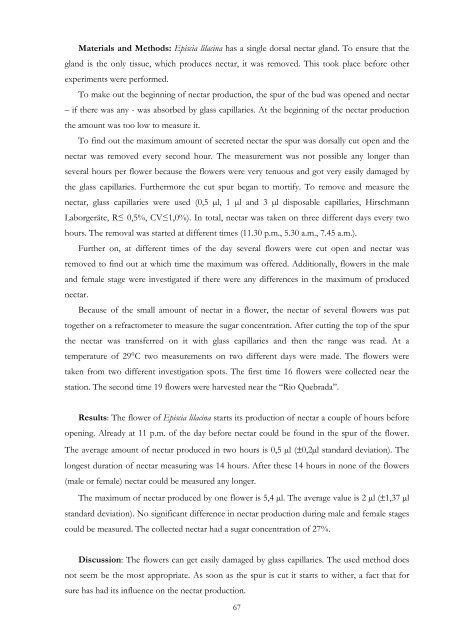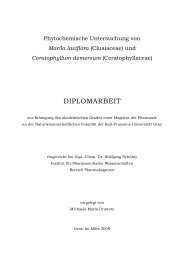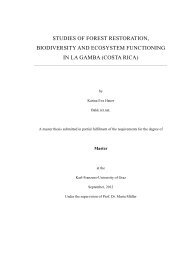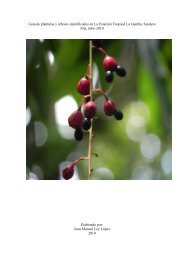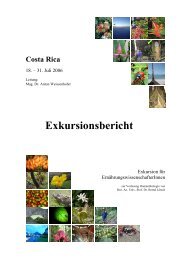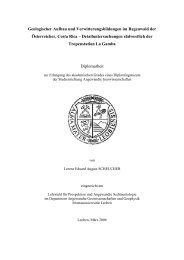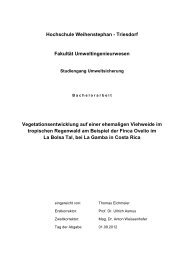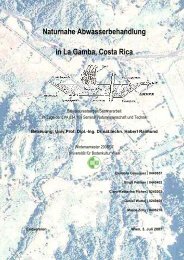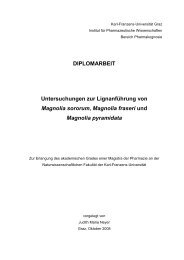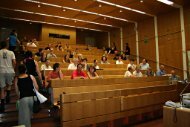Leaf colour patterns, vegetative and sexual reproduction of Episcia ...
Leaf colour patterns, vegetative and sexual reproduction of Episcia ...
Leaf colour patterns, vegetative and sexual reproduction of Episcia ...
You also want an ePaper? Increase the reach of your titles
YUMPU automatically turns print PDFs into web optimized ePapers that Google loves.
Materials <strong>and</strong> Methods: <strong>Episcia</strong> lilacina has a single dorsal nectar gl<strong>and</strong>. To ensure that the<br />
gl<strong>and</strong> is the only tissue, which produces nectar, it was removed. This took place before other<br />
experiments were performed.<br />
To make out the beginning <strong>of</strong> nectar production, the spur <strong>of</strong> the bud was opened <strong>and</strong> nectar<br />
– if there was any - was absorbed by glass capillaries. At the beginning <strong>of</strong> the nectar production<br />
the amount was too low to measure it.<br />
To find out the maximum amount <strong>of</strong> secreted nectar the spur was dorsally cut open <strong>and</strong> the<br />
nectar was removed every second hour. The measurement was not possible any longer than<br />
several hours per flower because the flowers were very tenuous <strong>and</strong> got very easily damaged by<br />
the glass capillaries. Furthermore the cut spur began to mortify. To remove <strong>and</strong> measure the<br />
nectar, glass capillaries were used (0,5 µl, 1 µl <strong>and</strong> 3 µl disposable capillaries, Hirschmann<br />
Laborgeräte, R≤ 0,5%, CV≤1,0%). In total, nectar was taken on three different days every two<br />
hours. The removal was started at different times (11.30 p.m., 5.30 a.m., 7.45 a.m.).<br />
Further on, at different times <strong>of</strong> the day several flowers were cut open <strong>and</strong> nectar was<br />
removed to find out at which time the maximum was <strong>of</strong>fered. Additionally, flowers in the male<br />
<strong>and</strong> female stage were investigated if there were any differences in the maximum <strong>of</strong> produced<br />
nectar.<br />
Because <strong>of</strong> the small amount <strong>of</strong> nectar in a flower, the nectar <strong>of</strong> several flowers was put<br />
together on a refractometer to measure the sugar concentration. After cutting the top <strong>of</strong> the spur<br />
the nectar was transferred on it with glass capillaries <strong>and</strong> then the range was read. At a<br />
temperature <strong>of</strong> 29°C two measurements on two different days were made. The flowers were<br />
taken from two different investigation spots. The first time 16 flowers were collected near the<br />
station. The second time 19 flowers were harvested near the “Rio Quebrada”.<br />
Results: The flower <strong>of</strong> <strong>Episcia</strong> lilacina starts its production <strong>of</strong> nectar a couple <strong>of</strong> hours before<br />
opening. Already at 11 p.m. <strong>of</strong> the day before nectar could be found in the spur <strong>of</strong> the flower.<br />
The average amount <strong>of</strong> nectar produced in two hours is 0,5 µl (±0,2µl st<strong>and</strong>ard deviation). The<br />
longest duration <strong>of</strong> nectar measuring was 14 hours. After these 14 hours in none <strong>of</strong> the flowers<br />
(male or female) nectar could be measured any longer.<br />
The maximum <strong>of</strong> nectar produced by one flower is 5,4 µl. The average value is 2 µl (±1,37 µl<br />
st<strong>and</strong>ard deviation). No significant difference in nectar production during male <strong>and</strong> female stages<br />
could be measured. The collected nectar had a sugar concentration <strong>of</strong> 27%.<br />
Discussion: The flowers can get easily damaged by glass capillaries. The used method does<br />
not seem be the most appropriate. As soon as the spur is cut it starts to wither, a fact that for<br />
sure has had its influence on the nectar production.<br />
67


